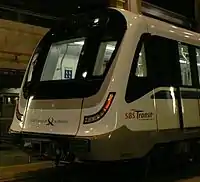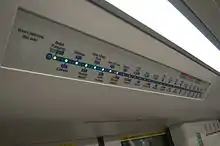Bombardier Movia C951/C951A
The Bombardier Movia C951 is a type of medium-capacity train built for Singapore's Downtown line. The contract was won by Bombardier Transportation[4] and the rolling stock was built by Changchun Bombardier Railway Vehicles (joint venture of Bombardier Transportation and CNR Changchun)[1][5][6] Initially, the authorities has ordered 73 trains,[6] although LTA had ordered an additional 15 trains[6] and a final 4 more trains under C951A which makes a total of 92 trainsets were manufactured under C951.[3]
Bombardier Movia C951
| |
|---|---|
 A C951 train. | |
 Interior of a C951 train | |
| In service | 22 December 2013 – Present |
| Manufacturer | Changchun Bombardier Railway Vehicles (Bombardier Transportation and CNR Changchun)[1] |
| Built at | Changchun, China |
| Family name | Movia |
| Constructed | 2012 – 2017 |
| Entered service | 2013 |
| Number built | 276 vehicles (92 sets)[2][3] |
| Number in service | 276 vehicles (92 sets) |
| Formation | 3 per trainset Mc1-T-Mc2 |
| Fleet numbers | 9001 – 9092 |
| Capacity | 931 Passengers |
| Operator(s) | SBS Transit DTL (ComfortDelGro Corporation) |
| Depot(s) | Gali Batu Tai Seng East Coast (Future) |
| Line(s) served | DTL Downtown line |
| Specifications | |
| Car body construction | Welded aluminium |
| Train length | 70.1 m (229 ft 11 7⁄8 in) |
| Car length | 23.37 m (76 ft 8 1⁄8 in) |
| Width | 3.2 m (10 ft 6 in) |
| Height | 3.68 m (12 ft 7⁄8 in) |
| Doors | 1,450 mm (57 1⁄8 in), 8 per car, 4 per side |
| Maximum speed | 90 km/h (56 mph) (Design) 80 km/h (50 mph) (Service) |
| Weight | 38.3 t (37.7 long tons; 42.2 short tons) per car |
| Traction system | IGBT–VVVF (Bombardier MITRAC 1000) |
| Traction motors | Totally enclosed fan-cooled Permanent Magnet Synchronous Motor (Bombardier DR1200) |
| Acceleration | 1.1 m/s2 (3.6 ft/s2) |
| Deceleration | 1.1 m/s2 (3.6 ft/s2) (Normal Braking) 1.4 m/s2 (4.6 ft/s2) (Emergency Braking) |
| Electric system(s) | 750 V DC third rail |
| Current collection method | Collector shoe |
| UIC classification | Bo'Bo' + 2'2' + Bo'Bo' |
| Braking system(s) | Regenerative Braking, Resistor Braking, Air Brakes (by Knorr Bremse Germany) |
| Safety system(s) | Siemens Trainguard Sirius Moving Block CBTC ATC with subsystems of ATO GOA 4 (UTO), ATP, Controlguide Rail 9000 ATS, Trackguard Westrace MK2 CBI |
| Coupling system | Scharfenberg |
| Track gauge | 1,435 mm (4 ft 8 1⁄2 in) standard gauge |
History
73 trainsets consisting of three cars each were purchased at a cost of approximately S$570.7 million for passenger service.[7] Bombardier beat Alstom, Kawasaki Heavy Industries and Hyundai Rotem in the tendering process as the lowest cost offered.[8][9] The tender for trains under the contract turnkey 951 was closed in June 2008, and awarded in November 2008.
Land Transport Authority later placed an additional order of 15 trainsets[10] in 2013 at an approximate value of $119.2 million.[11] LTA had increased the variation order from 15 to 19,[3] therefore bringing the total trainsets to 92. A partial number of the total fleet operates on the Stage 1 of Downtown Line since 22 December 2013. All 92 trains had completed their manufacturing in Changchun Bombardier Railway Vehicles factory, with some of them awaiting for their delivery into Singapore by mid-2017.[3]
Delivery
These trains were delivered until 2017. They are currently stabled at Gali Batu Depot, Kim Chuan Depot, Tai Seng Facility Building and the future East Coast Integrated Depot.
On 12 October 2012, the first of 11 trains for the Downtown Line Stage 1 arrived at Jurong Port and transported to Kim Chuan Depot to undergo testing by LTA before it is handed over to SBS Transit.[12]
By 28 February 2013, Bombardier had delivered nine of the 11 trains for Downtown Line Stage 1.[11] LTA together with the operator, SBS Transit conducted the necessary tests to ensure safety standards, functional performance and systems compatibility requirements are met before revenue service of the DTL1 which began on 22 December 2013.[13]
Features
Design
The C951 trains include several features that were not seen in existing trains.[14]
New features include:
- an ergonomic seat profile;
- red reserved seats, which allows for clearer separation between normal and reserved seats;
- perch seats, replacing the two-seaters at the ends of the car;
- hand grips utilising joints instead of straps, providing commuters a steadier grip;
The train will also retain existing features like having two rows of poles and hand grips, and vertical poles which split into three at the center.
Dynamic Route Map Display
The Dynamic Route Map Display (DRMD) is a rail travel information system, newly introduced and developed for the C951 trains. The dynamic route map display panels provide commuters with their journey status updates and route information. It also indicates which side the doors will open on. The Alstom Metropolis C830C and the Alstom Metropolis C751C feature the same DRMD.[15]
Bombardier has announced their intention to upgrade the DRMD from the current LED system to an LCD system, to accommodate future extensions to the Downtown line.[16]
Platform Gap Width Reduction (PGWR)
The train doors have a frangible gap made of rubber that protrudes out. The platform-train gap will then be reduced from 75 to 40 mm, preventing passenger accidents due to the platform gap.[15]
LCD Displays
C951 trains are also equipped with LCD Displays at each carriage, with a total of 18 LCD Displays on each train. They show advertisements, movie trailers and informercials related to the Downtown Line.
 A builder's plate, which also functions as a one-way camera concealing a security camera
A builder's plate, which also functions as a one-way camera concealing a security camera The DRMD of the C951
The DRMD of the C951 Emergency door unlock of the C951
Emergency door unlock of the C951 LED display on a C951 train
LED display on a C951 train
Automatic Track Inspection (ATI)
Four of the C951 trains also have their bogies installed with the ATI, which is a system of cameras, lasers, and sensors installed on trains that help to detect defects like rail cracks or missing fasteners.[17]
Train formation
The configuration of a C951 trainset in revenue service is DM1-T-DM2, permanently coupled. D stands for ″driver's desk", M for "motor″ and T for ″trailer″.
| Cars of C951 | ||||||||||
|---|---|---|---|---|---|---|---|---|---|---|
| car type |
Control Cab |
Motor | Collector Shoe |
Wheelchair Bay |
car length | |||||
| m | ft in | |||||||||
| DM | ✓ | ✓ | ✓ | ✗ | 23.65 | 77 ft 7 in | ||||
| T | ✗ | ✗ | ✓ | ✓ | 22.80 | 74 ft 10 in | ||||
The trainset numbers range from 9001 to 9092. The numbers are extended by one digit to denote individual cars. For example, trainset 9003 consists of cars 90031 (DM1), 90032 (T), and 90033 (DM2).
See also
- Movia
References
- Sim, Royston (18 November 2013). "Building a Downtown Line Train" (PDF). The Straits Times. Archived from the original (PDF) on 4 March 2016. Retrieved 1 August 2015.
- "Final Downtown Line train completed". Railway Gazette. 5 May 2016. Retrieved 8 July 2016.
- Bombardier MOVIA C951 - SGTrains Wiki
- "Tender Information". 28 February 2010. Archived from the original on 28 February 2010. Retrieved 8 July 2016.CS1 maint: bot: original URL status unknown (link)
- Barrow, Keith (28 March 2013). "More trains ordered for Singapore Downtown Line". International Railway Journal. Retrieved 1 August 2015.
- Chow, Jeremy (28 March 2013). "LTA orders 15 more trains for Downtown Line to reduce peak hour waiting time". The Straits Times. Archived from the original on 4 March 2016. Retrieved 1 August 2015.
- Bombardier Receives Contract from Land Transport Authority of Singapore for 219 Driverless Metro Cars Valued at Approximately 298 Million Euros
- Downtown train deal goes to Bombardier, Christopher Tan, The Straits Times, 8 November 2008
- "Downtown train deal goes to Bombardier". AsiaOne. 8 November 2008. Archived from the original on 21 September 2016. Retrieved 8 July 2016.
- Bombardier to Deliver Additional Trains for Singapore Downtown Line - Bombardier, 28 March 2013
- "Shorter Waiting Time With 15 More Trains For Downtown Line". Land Transport Authority. 28 March 2013. Retrieved 28 March 2013.
- "First Downtown Line train lands in Singapore". Land Transport Authority. Retrieved 16 November 2013.
- "Land Transport Masterplan: Downtown Line Stage 1 to open on 22 Dec". The Straits Times. Retrieved 16 November 2013.
- Arrival Of Downtown Line Train Mock-Up Archived 3 June 2011 at the Wayback Machine
- "Bombardier MOVIA C951/C951A". SGTrains.
- "Bombardier to enhance communication systems on the MOVIA metro fleet for Singapore's Downtown Mass Rapid Transit line". Bombardier Transportation. 3 September 2020. Retrieved 3 September 2020.
- "Factsheet: Technology for Depots and Trains to Improve Rail Reliability". Land Transport Authority. 13 November 2017.
External links
| Wikimedia Commons has media related to Bombardier MOVIA C951/C951A. |

.jpg.webp)